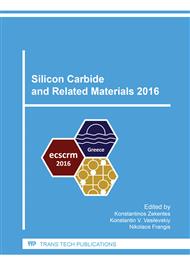p.327
p.331
p.335
p.340
p.344
p.348
p.352
p.356
p.363
Combined N2O and Phosphorus Passivations for the 4H-SiC/SiO2 Interface with Oxide Grown at 1400°C
Abstract:
Phosphorus (P) passivation is more effective than N2O passivation in improving the 4H-SiC/ SiO2 interface by reducing the number of traps at the 4H-SiC/SiO2 interface. This paper investigated the effect of combined N2O and phosphorus POA on the 4H-SiC/SiO2 interface with oxides grown at 1400°C and used in the fabrication of MOS capacitors and FETs. These fabricated devices are also compared with the ones which have been N2O and P passivations only. Results demonstrated that the phosphorus passivation technique provides the highest peak field-effect mobility for 4H-SiC MOSFETs (60 cm2/V.s), which is about 5 times higher than the value obtained for devices with N2O annealing. The combined N2O and phosphorus passivation technique, however, has shown a slight decrease in the peak field effect mobility value compared to the phosphorus passivation technique, but it is still much higher than the N2O passivation technique (12 cm2/V.s).
Info:
Periodical:
Pages:
344-347
Citation:
Online since:
May 2017
Authors:
Price:
Сopyright:
© 2017 Trans Tech Publications Ltd. All Rights Reserved
Share:
Citation:


